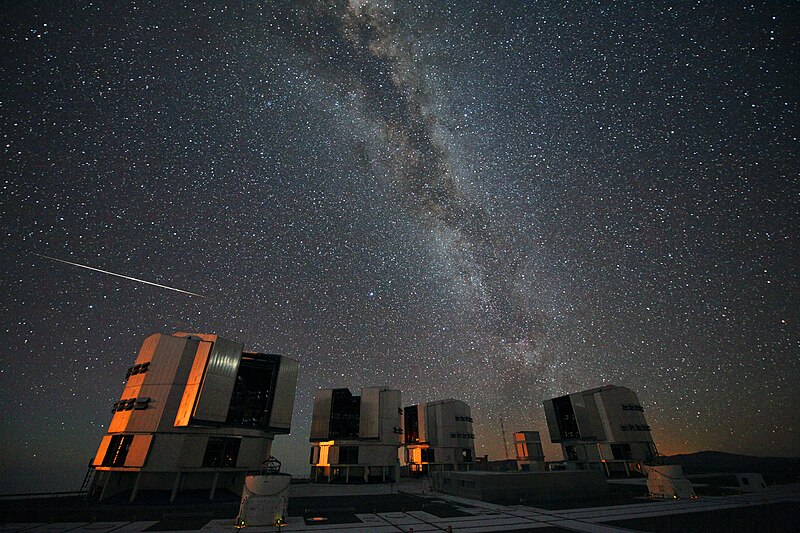Податотека:The 2010 Perseids over the VLT.jpg

Големина на овој преглед: 800 × 533 пиксели. Други разделности: 320 × 213 пиксели | 640 × 427 пиксели | 1.024 × 683 пиксели | 1.280 × 853 пиксели | 2.560 × 1.707 пиксели | 5.616 × 3.744 пиксели.
Изворна податотека (5.616 × 3.744 пиксели, големина: 5,68 МБ, MIME-тип: image/jpeg)
Историја на податотеката
Стиснете на датум/време за да ја видите податотеката како изгледала тогаш.
| Датум/време | Минијатура | Димензии | Корисник | Коментар | |
|---|---|---|---|---|---|
| тековна | 19:32, 19 февруари 2024 |  | 5.616 × 3.744 (5,68 МБ) | C messier | full size |
| 11:34, 18 август 2010 |  | 4.000 × 2.667 (5,82 МБ) | Lars Lindberg Christensen | {{Information |Description={{en|1=Every year in mid-August the Perseid meteor shower has its peak. Meteors, colloquially known as “shooting stars”, are caused by pieces of cosmic debris entering Earth’s atmosphere at high velocity, leaving a trail o |
Употреба на податотеката
Податотекава се користи во следнава страница:
Глобална употреба на податотеката
Оваа податотека ја користат и следниве викија:
- Употреба на af.wikipedia.org
- Употреба на ar.wikipedia.org
- Употреба на en.wikipedia.org
- Употреба на eo.wikipedia.org
- Употреба на es.wikipedia.org
- Употреба на fa.wikipedia.org
- Употреба на gl.wikipedia.org
- Употреба на he.wikipedia.org
- Употреба на hr.wikipedia.org
- Употреба на hu.wikipedia.org
- Употреба на it.wikipedia.org
- Употреба на la.wikipedia.org
- Употреба на ml.wikipedia.org
- Употреба на ms.wikipedia.org
- Употреба на my.wikipedia.org
- Употреба на nn.wikipedia.org
- Употреба на pl.wikipedia.org
- Perseidy
- Portal:Astronomia/Artykuł miesiąca 08 2012
- Portal:Astronomia/Artykuł miesiąca 08 2013
- Portal:Astronomia/Artykuł miesiąca 08 2014
- Portal:Astronomia/Artykuł miesiąca 08 2015
- Portal:Astronomia/Artykuł miesiąca 08 2016
- Portal:Astronomia/Artykuł miesiąca 08 2017
- Portal:Astronomia/Artykuł miesiąca 08 2018
- Portal:Astronomia/Artykuł miesiąca 08 2019
- Portal:Astronomia/Artykuł miesiąca 08 2020
- Portal:Astronomia/Artykuł miesiąca 08 2021
- Portal:Astronomia/Artykuł miesiąca 08 2022
- Употреба на ro.wikipedia.org
- Употреба на sh.wikipedia.org
- Употреба на sk.wikipedia.org
- Употреба на sl.wikipedia.org
- Употреба на sv.wikipedia.org
- Употреба на tr.wikipedia.org
- Употреба на vi.wikipedia.org
- Употреба на www.wikidata.org
- Употреба на zh.wikipedia.org

